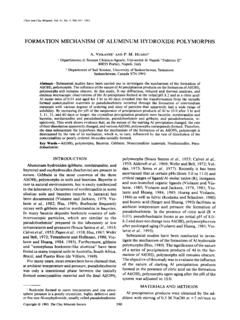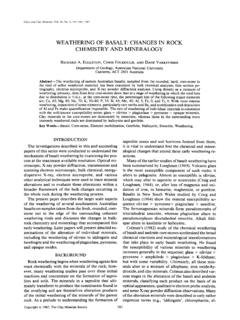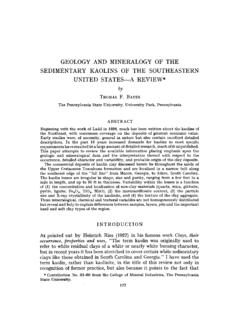Transcription of BLACK SHALE--ITS DEPOSITION AND DIAGENESIS 1
1 Clays and clay Minerals, VoL 27, No. 5, pp. 313-321, 1979. BLACK SHALE--ITS DEPOSITION AND DIAGENESIS 1 harry A. TOURTELOT Geological Survey, Federal Center, Denver, Colorado 80225 Abstract-- BLACK shale is a dark-colored mudrock containing organic matter that may have generated hy- drocarbons in the subsurface or that may yield hydrocarbons by pyrolysis. Many BLACK shale units are enriched in metals severalfold above expected amounts in ordinary shale . Some BLACK shale units have served as host rocks for syngenetic metal deposits. BLACK shales have formed throughout the Earth's history and in all parts of the world. This suggests that geologic processes and not geologic settings are the controlling factors in the accumulation of BLACK shale .
2 Geologic processes are those of DEPOSITION by which the raw materials of BLACK shale are accumulated and those of DIAGENESIS in response to increasing depth of burial. Depositional processes involve a range of relationships among such factors as organic productivity, clas- tic sedimentation rate, and the intensity of oxidation by which organic matter is destroyed. If enough or- ganic material is present to exhaust the oxygen in the environment, BLACK shale results. Diagenetic processes involve chemical reactions controlled by the nature of the components and by the pressure and temperature regimens that continuing burial imposes.
3 For a thickness of a few meters beneath the surface, sulfate is reduced and sulfide minerals may be deposited. Fermentation reactions in the next several hundred meters result in biogenic methane, followed successively at greater depths by decarbox- ylation reactions and thermal maturation that form additional hydrocarbons. Suites of newly formed min- erals are characteristic for each of the zones of DIAGENESIS . Key Words--- BLACK shale , DEPOSITION , DIAGENESIS , Organic matter, Syngenetic ores. INTRODUCTION The study of BLACK shales has been difficult until a relatively few years ago. Outcrop observations have yielded relatively few kinds of data for interpreting their origin and the factors governing their formation.
4 Re- cently, however, a growing body of chemical data on the organic as well as the inorganic constituents of BLACK shale has widened the scope of inferences that can be drawn on the genesis of such rocks. Current in- vestigations of eastern BLACK shale , particularly the Chattanooga shale and its correlatives of Late Devo- nian and Mississippian ages, as a source of gas (Schott et al., 1978) are producing a new generation of data; and the time is appropriate to review the processes in- volved in the accumulation of BLACK shale . Recently, data from deep-sea drilling, such as the composition of pore fluids, and new methods applied to the studies of organic matter and the formation of oil and gas have clarified many aspects of the DEPOSITION and DIAGENESIS of organic-rich sediments.
5 This paper summarizes the work of many specialists with emphasis on guides to the study and interpretation of BLACK shale sequences. DEFINITION OF BLACK shale BLACK shale is a dark-colored mudrock containing organic matter and silt- and clay -size mineral grains that accumulated together (Swanson, 1961, p. 69). Vine 1 Invited paper at 1978 clay Minerals Conference, Bloom- ington, Indiana. (1966, p. El-E2) pointed out the compositional varia- tions included in this definition and the ways that these variations can be used to study BLACK shale . Most shales that immediately meet this color crite- rion contain 1% or more organic carbon; 2-10% is a common range.
6 A few shales contain more than 20% organic carbon. Pyrolysis yields variable amounts of liquid and gaseous hydrocarbons, the amount depend- ing in part on the nature of the original organic material and in part on subsequent burial history. Minor amounts of authigenic carbonate minerals, either dis- persed in cements or in concretions, are characteristic features of many BLACK shale units. Most BLACK shales are marine and may have areal extents of thousands of square kilometers. BLACK shale units may have beds enriched in metals by factors greater than 50 for Ag, for example, and greater than 10 for Mo (Krauskopf, 1955, p.)
7 417). Such increased concentrations of Ag, Mo, Zn, Ni, Cu, Cr, V, and less commonly Co, Se, and U are conspicuous features of only some BLACK shales (Vine and Tourtelot, 1970, p. 270). IMPORTANCE OF BLACK shale BLACK shales are important to the natural fuel-re- source economy of the world because BLACK shales, along with their nonmarine analogue, coal, constitute the most important accessible reservoir of organic com- pounds in the Earth's crust. The organic matter may have generated liquid and gaseous hydrocarbons found in reservoir rocks in the subsurface into which they Copyright 9 1979, The clay Minerals Society 313 314 Tourtelot Clays and clay Minerals have migrated.
8 Recently, however, the potential of BLACK shale itself as a reservoir for gaseous hydrocar- bons has been recognized, and this potential is being explored intensively. Estimates of the gas content of the Chattanooga shale , for instance, range from tens to thousands of trillion cubic feet ( Dept. of Ener- gy, 1977, p. 99; Brown, 1976, p. 94). Hydrocarbons also can be obtained by pyrolysis from thermally immature BLACK shale . Increasing atten- tion will be given to this possibility as demands increase and supplies from conventional sources dwindle. BLACK shale units also are important as syngenetic hosts for metal deposits.
9 The Kupferschiefer of Perm- ian age in central Europe is a spectacular example of a metal-enriched BLACK shale , containing a few percent Cu and Pb. Recent lead-isotope data clearly indicate that the metals in the Kupferschiefer were incorporated syngenetically in the shale (Wedepohl et al., 1978). The lead-zinc deposits at Rammelsberg in West Germany are in organic-rich rocks of Devonian age and have a similar origin. The Nonesuch shale of Proterozoic age has been mined for copper in Michigan (Ensign et al., 1968, p. 464), and at least part of the copper is synge- netic. Oklo, the natural nuclear reactor and uranium deposit in Africa, may represent a maximum concen- tration of uranium in which the BLACK shale involved may have played an important role in localizing the de- posit and in retaining fission products (Brookins, 1976).
10 In Sweden, alum shales of Cambrian age containing about 14% organic carbon have been used as a source of pyrolytic oil and uranium (Armands, 1972). Only a few metal deposits have been found in BLACK shale units in the United States, but others have not yet been sought systematically. The rich deposits of Ram- melsberg occupy less than a square kilometer (Anger et al., 1%6). It is still possible that the rocks in a similar small area of the Chattanooga shale , for instance, are rich enough in metals to constitute an ore deposit. Oth- er metal-rich BLACK shales may eventually serve as metal sources whenever normal sources are depleted (Davidson and Lakin, 1961, 1962; Vine and Tourtelot, 1970).















